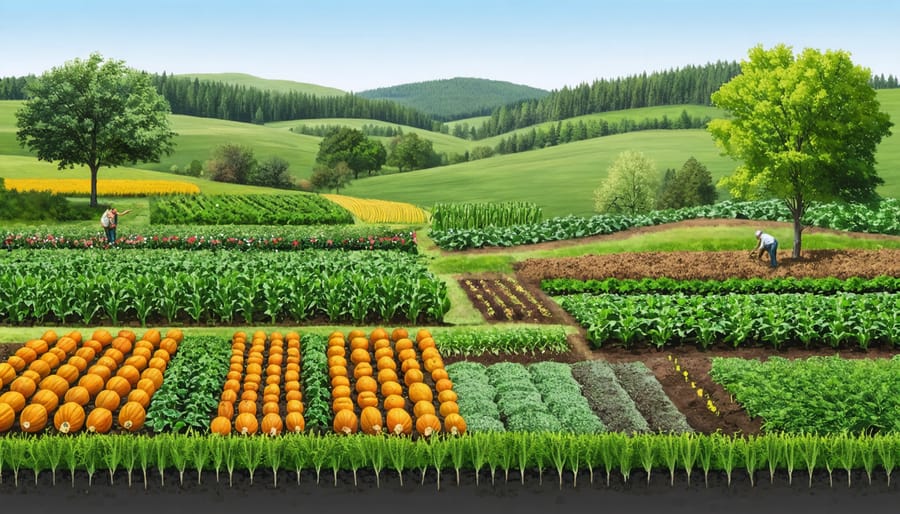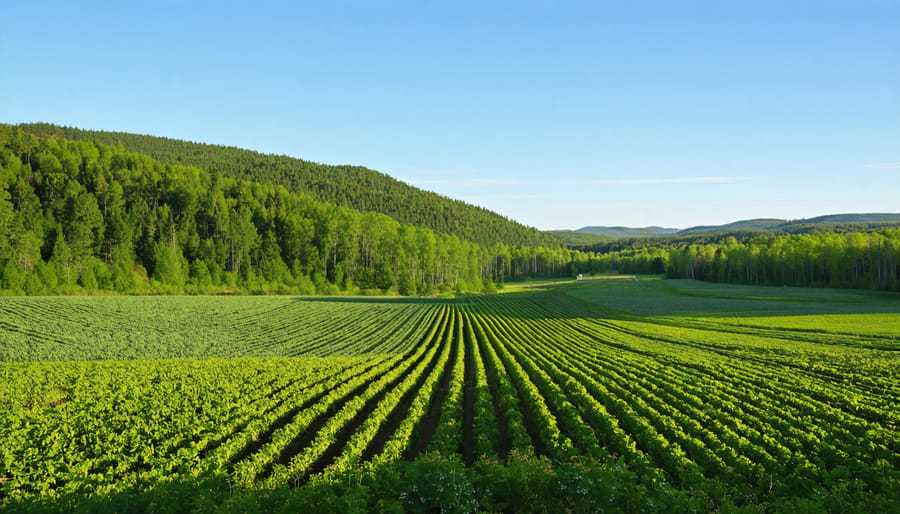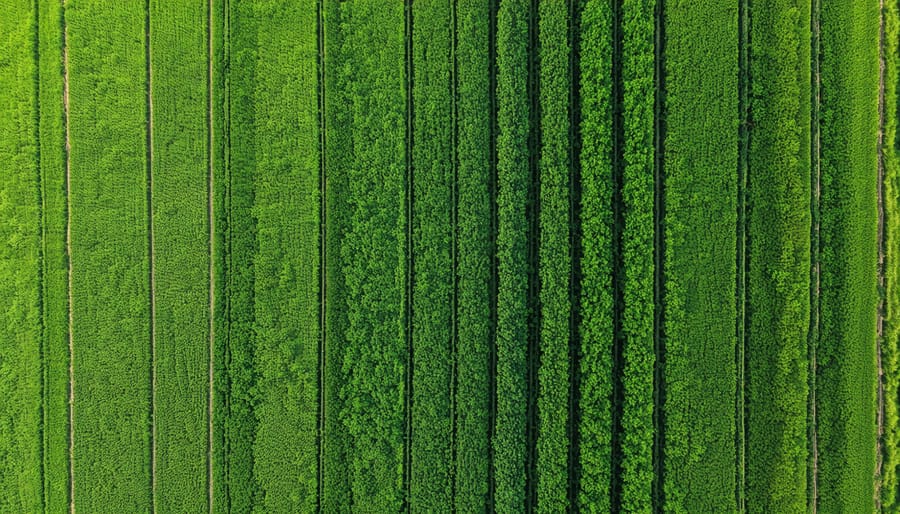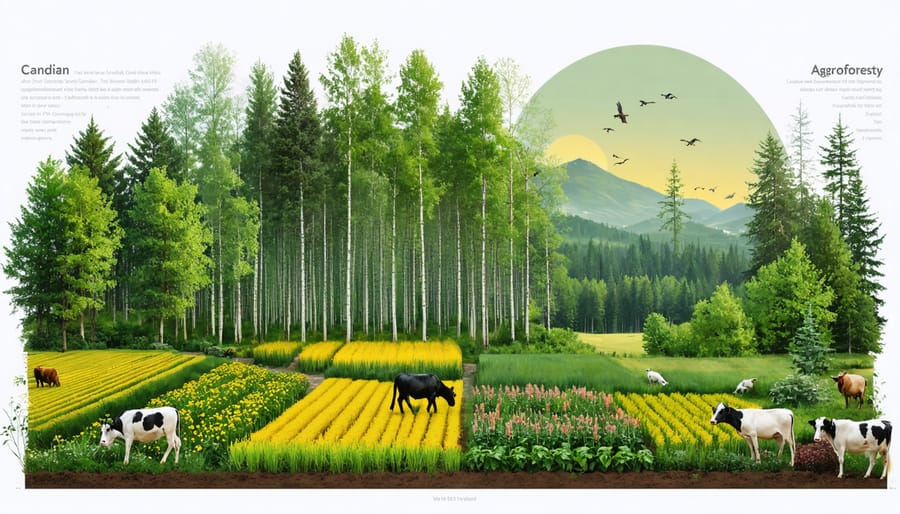Diversify crop rotations by integrating at least three different plant families to strengthen soil health and natural pest resistance. Establish strategic buffer zones with native plants along field edges to support beneficial insects and create natural corridors for pollinators. Design your agricultural system to include multiple vertical layers – from root crops to canopy trees – mimicking natural forest structures while maximizing land use efficiency.
Alberta farmers are increasingly adopting these climate-resilient farming practices to enhance agrobiodiversity, seeing up to 30% yield increases while reducing input costs by 25%. This integrated approach to agricultural biodiversity doesn’t just protect against crop failure – it builds resilient farming systems that thrive in our changing prairie climate while supporting local ecosystems.
By strategically combining livestock, crops, and beneficial insects, Canadian farmers create robust agricultural systems that naturally maintain pest control, improve soil fertility, and increase farm productivity. These time-tested methods, adapted for our unique growing conditions, demonstrate how traditional ecological knowledge and modern farming can work together to secure our agricultural future.
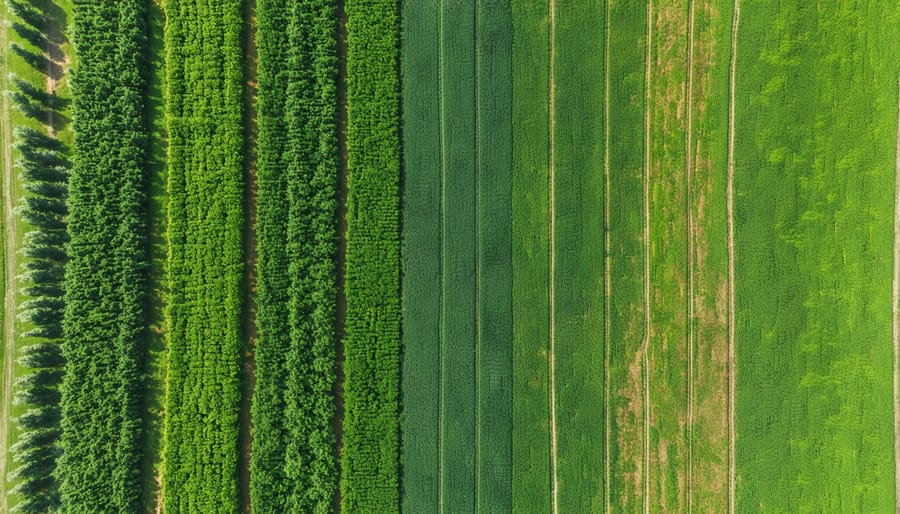
The Power of Plant Diversity in Alberta’s Agroforestry
Native Species Integration
The integration of native species into agroforestry systems plays a crucial role in maintaining ecological balance while supporting agricultural productivity. In Alberta, indigenous plants like saskatoon berries, chokecherries, and wolf willow have evolved alongside local wildlife and are naturally adapted to our climate conditions, requiring less irrigation and maintenance than introduced species.
These native varieties offer multiple benefits to farming operations. They provide natural windbreaks, prevent soil erosion, and create wildlife corridors that support beneficial insects and pollinators. For example, the thorny buffaloberry, common in central Alberta, fixes nitrogen in the soil while producing edible berries that can be harvested as a secondary crop.
Local farmers have reported significant success incorporating native species like red osier dogwood and high bush cranberry into their operations. These plants not only enhance biodiversity but also create additional revenue streams through berry production and value-added products. The deep root systems of native plants improve soil structure and water retention, making farms more resilient to drought conditions.
When selecting native species, consider your specific growing zone and soil conditions. Many native plant nurseries in Alberta offer consultation services to help farmers choose appropriate varieties for their land. Starting with small trial areas can help determine which species work best in your specific growing conditions while minimizing initial investment risks.
Companion Planting Success Stories
Several Alberta farmers have transformed their operations through strategic companion planting, demonstrating the practical benefits of agrobiodiversity. The Petersons, who farm near Leduc, successfully integrated pulses with their wheat crops, reporting a 15% increase in yield and improved soil nitrogen levels over three growing seasons.
In the Peace Country region, Sarah Martinez’s market garden operation showcases the power of traditional Indigenous companion planting methods. Her “Three Sisters” garden combines corn, climbing beans, and squash, utilizing natural symbiotic relationships. Martinez notes that this approach has reduced pest problems by 40% while maximizing her limited growing space.
Near Red Deer, the Morrison Family Farm has revolutionized their approach to pest management through strategic intercropping. By planting aromatic herbs like dill and cilantro alongside their vegetable crops, they’ve significantly reduced pest pressure without chemical interventions. Their careful documentation shows a 30% reduction in pest-related crop damage.
The Wheatland County Community Garden project demonstrates how companion planting can work on a larger scale. Their innovative approach includes marigolds bordering tomato patches and nasturtiums protecting cucumber plants. Garden coordinator James Thompson reports that participating families have seen improved yields and reduced pest issues while learning valuable lessons about ecosystem balance.
These success stories highlight how thoughtful plant combinations can enhance farm resilience while supporting local biodiversity.
Animals and Insects: The Hidden Heroes
Pollinators and Pest Management
Beneficial insects play a crucial role in maintaining healthy and productive agricultural systems across Alberta. These natural allies fall into two main categories: pollinators, which ensure successful crop reproduction, and predatory insects that help control pest populations.
Native bees, including bumble bees and mason bees, alongside managed honey bee colonies, contribute significantly to crop yields in canola, alfalfa, and fruit orchards. Research from the University of Alberta shows that diverse pollinator populations can increase crop yields by up to 30% in certain varieties.
Creating pollinator-friendly habitats through hedgerows, flowering cover crops, and maintaining natural areas around fields helps support these beneficial insects. Many Alberta farmers have found success by leaving strips of native flowering plants along field edges and establishing bee hotels for solitary pollinators.
For pest management, beneficial insects like lady beetles, parasitic wasps, and ground beetles provide natural pest control services. These insects can significantly reduce the need for chemical pesticides when properly supported through habitat conservation and integrated pest management practices.
Local farming networks have demonstrated that maintaining diverse field margins and implementing beetle banks can increase beneficial insect populations while reducing pest pressure. These practices not only support farm productivity but also contribute to the overall resilience of agricultural ecosystems.
Consider monitoring beneficial insect populations throughout the growing season and adjusting management practices to protect these valuable allies during critical periods of pest control and pollination.
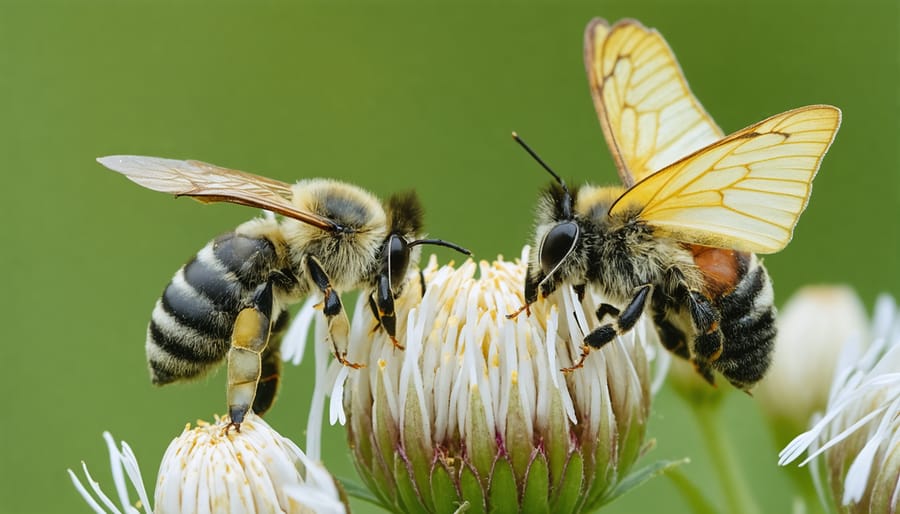
Livestock Integration Strategies
Strategic livestock integration is a cornerstone of successful integrated farming approaches, particularly in Alberta’s diverse agricultural landscape. When properly managed, animals can significantly enhance the productivity and sustainability of agroforestry systems while creating additional revenue streams for farmers.
Rotational grazing serves as a primary method, where livestock move through different sections of the forest system in planned sequences. This approach helps control undergrowth, naturally fertilizes soil, and maintains optimal vegetation levels. In Alberta, many farmers successfully integrate cattle in silvopasture systems, allowing animals to graze among trees while benefiting from natural shelter.
Smaller livestock, such as sheep and goats, excel at vegetation management in young orchards and woodlots. These animals effectively control weeds without damaging tree bark or root systems. Poultry integration has gained popularity, with free-range chickens and turkeys helping with pest control while providing eggs and meat as secondary products.
For optimal results, consider these key strategies:
– Match livestock density to available forage
– Rotate animals seasonally to prevent overgrazing
– Protect young trees with temporary fencing
– Provide adequate water sources throughout the system
– Monitor soil health and adjust grazing patterns accordingly
This multi-species approach creates a more resilient and productive farming system while supporting natural biodiversity.

Soil Biodiversity: The Foundation of Success
Microorganism Management
Healthy soil microorganisms are the foundation of successful farming in Alberta’s diverse agricultural landscapes. These beneficial organisms, including bacteria, fungi, and other microscopic life forms, work tirelessly to maintain soil health and support crop productivity.
To promote beneficial soil life, start by minimizing tillage operations, which can disrupt established microbial communities. Instead, consider implementing no-till or reduced tillage practices, which have shown excellent results across Prairie provinces. Adding organic matter through crop residue and cover crops provides food sources for microorganisms while improving soil structure.
Local success stories, like the Morrison family farm near Red Deer, demonstrate how rotating crops with different root structures can enhance microbial diversity. They’ve reported improved soil stability and increased yields after implementing these practices for just three years.
Maintaining proper soil moisture levels is crucial for microbial activity. Consider using mulch or organic ground covers to regulate soil temperature and moisture. Avoid excessive use of synthetic fertilizers and pesticides, which can harm beneficial microorganisms. Instead, focus on building natural soil fertility through composting and green manuring.
Regular soil testing helps monitor microbial activity and overall soil health. Many Alberta agricultural extension offices offer soil biology assessments to help farmers track their progress and adjust management practices accordingly. Remember that healthy soil microorganisms contribute to increased nutrient availability, better water retention, and enhanced crop resilience.
Cover Cropping Strategies
Cover crops are a cornerstone of soil health management in Alberta’s agricultural systems, offering multiple benefits for enhancing biodiversity both above and below ground. Many local farmers have found success with cold-hardy varieties like fall rye, winter wheat, and hairy vetch, which can withstand our challenging climate while providing excellent soil coverage.
To maximize biodiversity benefits, consider implementing a diverse cover crop mix rather than a single species. For example, combining legumes like field peas with cereals like oats creates multiple root depths and structures, supporting different soil microorganism communities. This approach has shown particular success in the Black Soil Zone regions of central Alberta.
Timing is crucial for cover crop success in our shorter growing season. Plant spring cover crops as soon as soil temperatures reach 5°C, typically in early May for most regions. For fall coverage, seed winter-hardy varieties by late August to ensure adequate establishment before frost.
Local farmer Mike Thompson from Lacombe County shares, “We’ve seen dramatic improvements in soil structure and earthworm populations since implementing a three-species cover crop rotation. The key is choosing species that complement each other and serve multiple purposes.”
To enhance effectiveness, consider these practical strategies:
– Interseed cover crops into standing cash crops
– Use roller-crimping for natural termination
– Leave root systems intact when possible
– Monitor soil moisture levels to prevent competition with main crops
Remember that success with cover crops often requires patience and experimentation to find the right combination for your specific soil conditions and climate challenges.
Practical Implementation Steps
Assessment and Planning
Assessing agrobiodiversity on your farm begins with systematic observation and documentation. Start by conducting seasonal biodiversity audits, which involve mapping different species of crops, beneficial insects, and wildlife present on your land. This foundational step helps establish a baseline for developing sustainable agricultural systems.
Key assessment tools include:
– Species counting and identification guides
– Soil testing kits for biological activity
– Photo documentation of different farm zones
– Field notebooks for seasonal observations
– Digital mapping tools and GPS markers
Consider partnering with local agricultural extension services or conservation groups who can provide expertise in species identification and monitoring techniques. Many Alberta farmers find success using the Prairie Farm Assessment Tool, which helps evaluate biodiversity indicators specific to our region.
Create a yearly timeline for monitoring, typically including:
– Spring emergence surveys
– Summer pollinator counts
– Fall harvest biodiversity assessments
– Winter wildlife tracking
Document changes in soil health, water retention, and pest presence. This data helps identify trends and guides future planning decisions. Remember to include indigenous plant species in your assessment, as they often play crucial roles in local ecosystems.
For best results, maintain consistent recording methods and schedule regular reviews of your findings with agricultural advisors or fellow farmers in your community.
Seasonal Management Tips
Managing agrobiodiversity requires a thoughtful approach throughout the year. In spring, focus on soil preparation and seed selection, prioritizing heritage varieties well-suited to Alberta’s climate. Consider establishing windbreaks and hedgerows using native species like saskatoon berry and chokecherry, which provide both biodiversity benefits and potential income streams.
Summer maintenance should include implementing integrated pest management strategies. Rather than relying solely on chemical controls, encourage beneficial insects by maintaining flowering strips and beetle banks. Regular monitoring helps identify potential issues before they become severe, allowing for targeted interventions that preserve beneficial species.
Fall presents opportunities for cover cropping and collecting seeds from successful heritage varieties. Consider leaving some crop residue and establishing winter cover crops to provide habitat for overwintering beneficial insects and soil microorganisms. This practice also helps prevent soil erosion during Alberta’s windy seasons.
Winter is ideal for planning next season’s crop rotations and reviewing biodiversity management strategies. Use this time to participate in seed exchanges with other local farmers and attend workshops on innovative biodiversity practices. Consider establishing winter shelterbelts that provide refuge for local wildlife while protecting fields from harsh winter winds.
Remember that successful agrobiodiversity management often requires patience – changes may take several seasons to show results. Start with small, manageable areas and gradually expand as you develop experience with different techniques and their outcomes in your specific context.
As we’ve explored throughout this article, agrobiodiversity offers tremendous benefits for Alberta’s farming communities. By embracing diverse crop rotations, integrating livestock, and maintaining healthy soil ecosystems, farmers can build more resilient and productive agricultural systems that stand the test of time.
The evidence is clear: farms implementing agrobiodiversity principles typically see improved yields, better pest resistance, and enhanced soil fertility. These benefits translate into tangible economic advantages while contributing to environmental sustainability. Many Alberta farmers have already witnessed reduced input costs and increased profit margins through these practices.
Taking the first steps toward greater agrobiodiversity doesn’t have to be overwhelming. Start small by introducing one or two new crop varieties, establishing beneficial insect habitats, or experimenting with cover crops on a portion of your land. Local agricultural extension services and experienced neighbours are valuable resources for guidance and support.
Remember, each farm’s journey toward greater biodiversity will look different. What works for a operation near Lethbridge may need adjustment for farms in the Peace Country. The key is to observe, adapt, and build on successes while learning from challenges.
By working together and sharing experiences, Alberta’s farming community can lead the way in creating more diverse, resilient, and profitable agricultural systems. The future of sustainable farming lies in the biological richness we nurture today.



